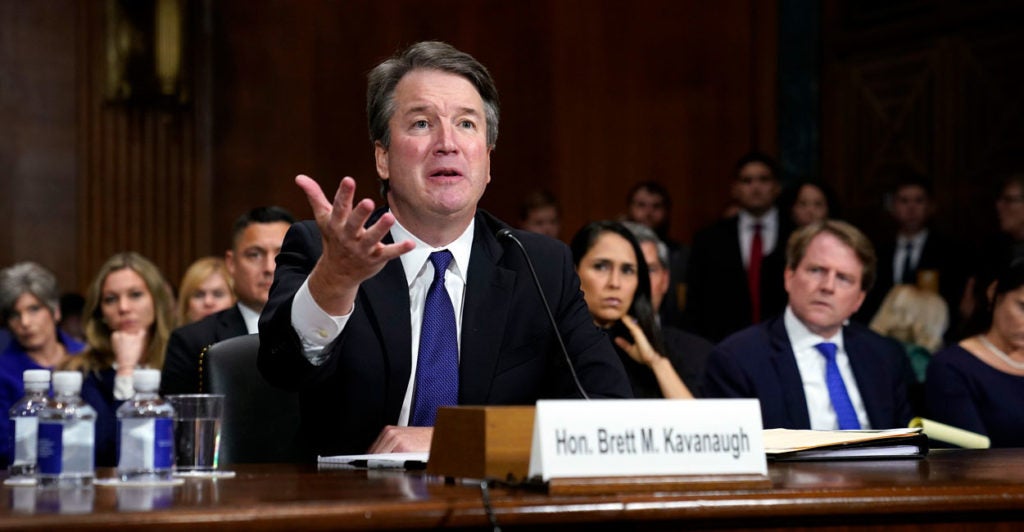The 50-48 Senate vote to confirm Brett Kavanaugh’s nomination to the Supreme Court was the closest confirmation since 1881, when Justice Stanley Matthews was approved by a vote of 24-23.
President Donald Trump may well get another Supreme Court pick before he leaves office and, in the meantime, he can certainly expect aggressive opposition to his lower court nominations to continue. This is, therefore, a good time to examine the opposition to Kavanaugh and the campaign waged against him.
The extreme opposition to Kavanaugh cannot be explained by the fact that he is considered “conservative.” Kavanaugh is no more conservative than, say, Justice Ruth Bader Ginsburg was liberal when the Senate voted 96-3 to approve her nomination in 1993.
Nor do his qualifications explain the opposition. He had, for example, served for a dozen years on the U.S. Court of Appeals—longer than three-quarters of all Supreme Court justices who had served on that court. The American Bar Association unanimously gave Kavanaugh its highest “well qualified” rating.
The opposition is not limited to Trump’s Supreme Court nominees. His appeals court nominees who enjoy the American Bar Association’s highest rating have received, on average, more than three times as many negative confirmation votes as President Barack Obama’s nominees, five times as many as President George W. Bush’s nominees, and six times as many as those of President Bill Clinton.
More than half of Trump’s lower court nominations have had at least one negative vote for confirmation, compared to only 4 percent for the previous five presidents in their first two years. Overall, Trump’s nominations have received an average of 17 negative votes, compared to less than one negative vote for his predecessors’ nominations.
No, the issue is not Kavanaugh’s conservatism or lack of qualifications. The desperate, no-holds-barred opposition to him reflects something familiar as well as something new.
As in the past, this episode shows that the left sees the courts as the way to seize power and impose their political agenda. They want judges who take sides, who favor certain parties, and who decide cases with an eye toward how their decisions will promote particular political interests.
For the left, the political ends justify the judicial means.
This opposition to impartial judges is even more intense when the nominee is a racial minority or a woman. Look how hard the left fought Clarence Thomas’ Supreme Court nomination in 1991.
A dozen years later, Senate Democrats blocked Miguel Estrada’s nomination to the U.S. Court of Appeals because, as internal strategy memos confirmed, “he is Latino, and the White House seems to be grooming him for a Supreme Court appointment.”
Democrats also filibustered the nomination of 5th Circuit Judge Priscilla Owen four times, even though the American Bar Association unanimously gave her its highest rating.
It’s no wonder, then, that the left would oppose the judges Trump is appointing. Trump’s judges are much more in line with the design of America’s Founders, whose plan included a limited role for judges so that the people and their elected representatives would govern.
>>> What We Need in Our Federal Judges
That debate over whether America needs impartial or political judges is familiar. What is new is that the left’s opposition to impartial judges is made more ferocious by its opposition to Trump himself. Increasingly, the left uses Trump’s nominees (including to the executive branch) as proxies for the president who chose them.
This is one reason that the left will not stop simply because Kavanaugh was appointed. It will argue that his decisions are not only wrong, but illegitimate.
Barely an hour after Kavanaugh’s confirmation was certain, for example, Vox published an article titled “Brett Kavanaugh’s confirmation will delegitimize the Supreme Court—and that’s good: It’s time America woke up to the radical right that’s run the court for years.”
This unmasks the consequences of the unelected, life-tenured judiciary no longer being the “weakest” and “least dangerous” branch as America’s Founders intended. When the judiciary has more power than it should, the process of appointing its members will necessarily be more contentious than it should.
Justice Antonin Scalia addressed this when he dissented in Planned Parenthood v. Casey in 1992. If the Constitution makes value judgments to be dictated by judges rather than voted on by the people, he wrote, “we can have a sort of plebiscite each time a new nominee to [the court] is put forward.”
The left’s assault on Trump’s judicial nominees shows that is the point we’ve reached today.
The best way forward is to properly understand how we got here. The conflict over judicial appointments is the conflict over judicial power, and the left has shown it will do anything to seize power by capturing the judiciary.
This puts us at a crossroads and presents a choice for America’s future.
